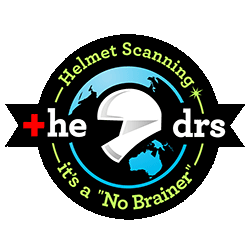Where the magic starts
- Shearography
- Holography &
- Interferometry
Shearograpghy
Following the first invention of lasers in 1960, Shearography was first invented in 1973 by Yau Y. Hung and Charles E. Taylor, known as the Speckle-Shearing Interferometric Camera , describing it as a tool for measurement of derivatives of surface-displacements.
As previously mentioned in the Technical Design section, under the subhead of – OUR R&D IN NDT METHODS OF A MOTORCYCLE HELMET, Shearography is a contactless NDT full technical field where two shifted images interfere to provide real-time information on the location of the outer skin of the observed object.
The Helmet Doctors observe heterogeneities in the deformation of the outer skin of the object.
This deformation can be induced thermally (thermal expansion) as a result of mechanical stress or by vibration.
Figure 1: Schematic diagram of a mounting shearographique

To free ourselves from the observed sample pattern, we use the Phase-stepping technique that brings out information on the position.
We take several measures known as inducing deformation by moving one of the mirrors using a piezoelectric actuator. We can then extract the optical phase that is proportional to the distance between the optical head and skin of the object. By subtracting the phase in real-time and a registered phase serving as a reference, we obtain information on the deformation of the skin of the sample since the moment when the reference was taken.
In shearography, the gap between the two images is called shear. It is characterized by a direction and a distance. The distance of the shear is usually measured at the observed object.
The phase difference requires heavy filtering work to be exploitable. In shearography, the result of the measurement is the spatial derivative of the deformation of the skin of the object observed according to the orientation of the shear, unlike other industrial holography methods which directly measure the deformations.
The larger the shear, the better the sensitivity of the technique to the detriment of sensitivity to environmental disturbances. The smaller the shear, the more sensitive it becomes.
Holography
Holography was invented in 1948 by Dennis Gabor purely as a research tool. At the time Dr. Gabor was interested in a way of increasing the magnification of electron microscopes and hit upon the idea of “wavefront reconstruction ” – now called holography -for which he won a Nobel in 1971.
Throughout the 50’s holography remained a subject of purely scientific interest with no obvious applications in industry or engineering. This was primarily due to the lack of a coherent source with which to record the hologram.
This problem was solved in Michigan by Leith and Upatnieks in 1963, the first group to use a laser in the recording of a hologram.
These holograms, however, were only viewable in laser light and therefore were still not able to transcend into the mainstream of industrial processes or engineering techniques.
In 1963 Y. Denisyuk invented a method to make holograms viewable in standard “white light” , i.e. non-coherent sources, creating what is today called a “reflection hologram”, while in 1969 Dr. Benton at Polaroid created another method of allowing white light viewability resulting in what is today called a “rainbow hologram” . These two advances allowed holography to escape from a laboratory environment.
Holography entered the public space with the advent of embossed holography. This is a technique where a hologram can be imprinted onto foil, which can be adhered to paper or cards by standard embossing methods and makes it possible to mass-produce holograms cheaply. The major application today is in security, where holograms are a standard security feature on credit cards.
Holography vs Shearography
- Holography employs interferometry by using two beams of laser light.
- Shearography on the other hand, employs a single beam of laser light which is reflected off the specimen.
Interferometry
The interferometer was invented by German American physicist Albert A. Michelson (1852–1931) around 1881.
Interferometry is a technique of using the principles of splitting the electromagnetic wave into partial waves through reflection and refraction and uniting these partial waves after the two beams have passed equal paths.
Conclusion- Holographic interferometry
Holographic interferometry is a powerful whole-field optical method allowing objects surface displacement measurement in the micrometric to submicrometric ranges.
Holographic interferometry consists in producing the interface between two wavefronts at least one of which is recorded as a hologram in photosensitive materials.
The recorded step requires the superimposition of the object beam having travelled via the observed object and a coherent reference beam taken from the same light source. At the readout step the hologram is illuminated by the same reference beam that has served for the recording.



